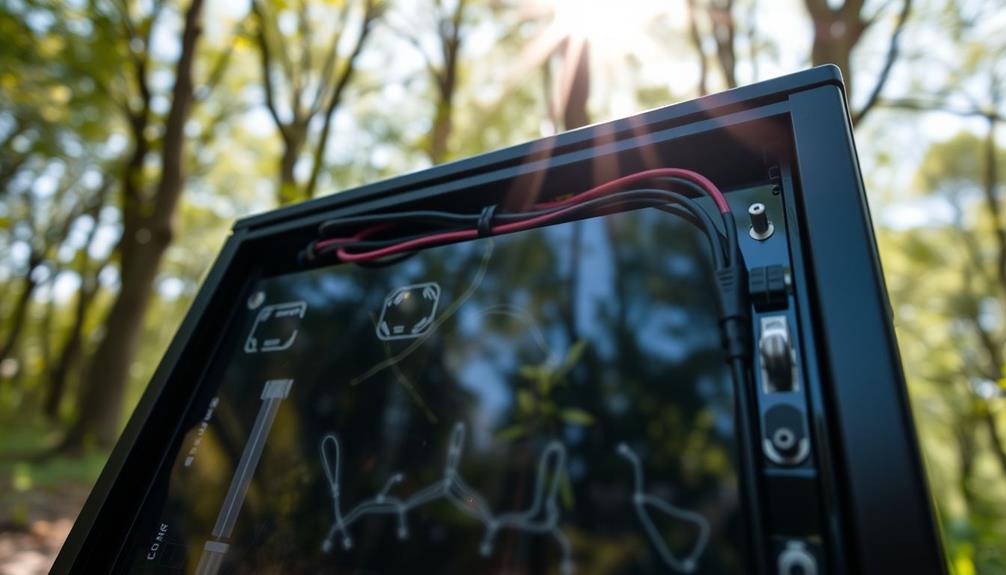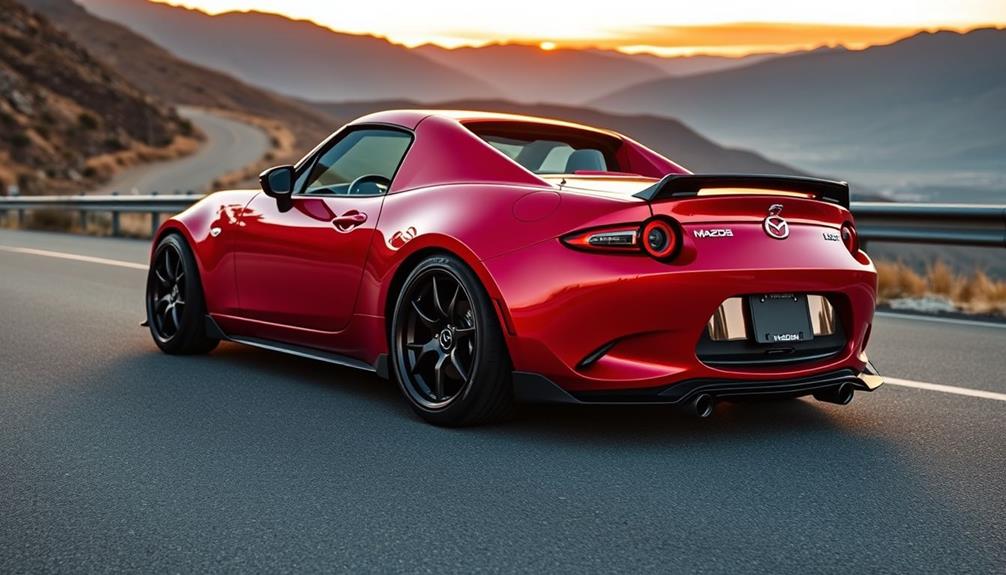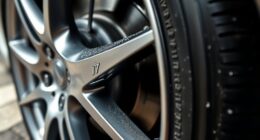Tuning your 2000 Mazda Protege can boost both power and efficiency, turning your compact car into an exciting machine. Start with basic upgrades like a cold air intake and high-flow exhaust, which can add 20-25 whp. Lightweight wheels and flywheels improve acceleration and throttle response, making your ride more engaging. For significant power gains, consider turbocharging, but be sure to invest in supporting modifications and a proper ECU reflash to optimize performance. Engaging with the automotive community will uncover valuable insights and tips for effective upgrades, revealing even more options for enhancing your Protege.
Key Takeaways
- Upgrade the cold air intake and high-flow exhaust system for a combined 20-25 whp increase and improved engine efficiency.
- Consider lightweight components such as flywheels and wheels to enhance throttle response and acceleration without significant investment.
- Reflash the ECU to optimize fuel and ignition maps, maximizing performance for naturally aspirated setups.
- Explore turbocharging options for substantial power gains, ensuring supporting mods for longevity and reliability.
- Engage with the automotive community for cost-effective upgrade tips and to share experiences on effective tuning strategies.
Overview of Tuning Options
When it comes to tuning your 2000 Mazda Protege, you've got several exciting options to boost performance and enhance your driving experience. One of the simplest ways to achieve a power increase is by making basic modifications like upgrading your intake and exhaust systems. These changes can deliver an impressive 20-25 wheel horsepower, giving your Protege a noticeable lift in performance.
If you're looking for quicker throttle response and improved acceleration, consider swapping out to a lightweight flywheel and wheels. Reducing rotational mass considerably enhances your car's responsiveness.
For those willing to dive deeper into tuning, turbocharging can offer substantial power gains, but it's often best to look at platforms like the Mazda Speed 3 or 6 for improved reliability.
Don't underestimate the importance of proper tuning. Reflashing the MP3 ECU can maximize the performance of your naturally aspirated setup, ensuring you get the best power delivery.
Key Performance Modifications

Key performance modifications can transform your 2000 Mazda Protege into a more exhilarating driving machine. One of the most effective upgrades you can make is enhancing the intake system. A cold air intake, for example, improves airflow, which can yield a noticeable increase in horsepower.
Pair this with a high-flow exhaust system, and you could see gains of 20-25 whp from improved engine efficiency.
Don't overlook lightweight components either. Installing lightweight wheels and a flywheel reduces overall vehicle weight and rotational mass, enhancing acceleration and throttle response.
Additionally, consider a performance ECU reflash, specifically the MP3 ECU. This adjustment optimizes fuel and ignition maps, offering significant performance improvements for naturally aspirated setups.
Lastly, adding headers promotes better exhaust flow, making it an essential modification for maximizing engine performance.
These basic bolt-on modifications aren't only cost-effective but can also lead to a more enjoyable driving experience. By focusing on these key performance modifications, you'll reveal the full potential of your Mazda Protege, making it a fun and responsive compact car on the road.
Understanding Forced Induction

Forced induction is a game-changer for boosting the performance of your 2000 Mazda Protege. By utilizing turbocharging, you can considerably increase your engine's power output, often offering better power per dollar compared to traditional modifications. However, choosing the right components is essential. Larger turbos, like the GT30 or GT35, can deliver impressive power but may introduce lag, affecting your car's drivability.
Here's a quick overview of key considerations for forced induction:
| Aspect | Details |
|---|---|
| Tuning | Important for ideal performance across the RPM range. |
| Component Selection | Larger turbos can boost power but may sacrifice low-end performance. |
| Supporting Mods | Upgraded intercoolers and fuel systems are critical for longevity. |
Cost-Effectiveness of Upgrades
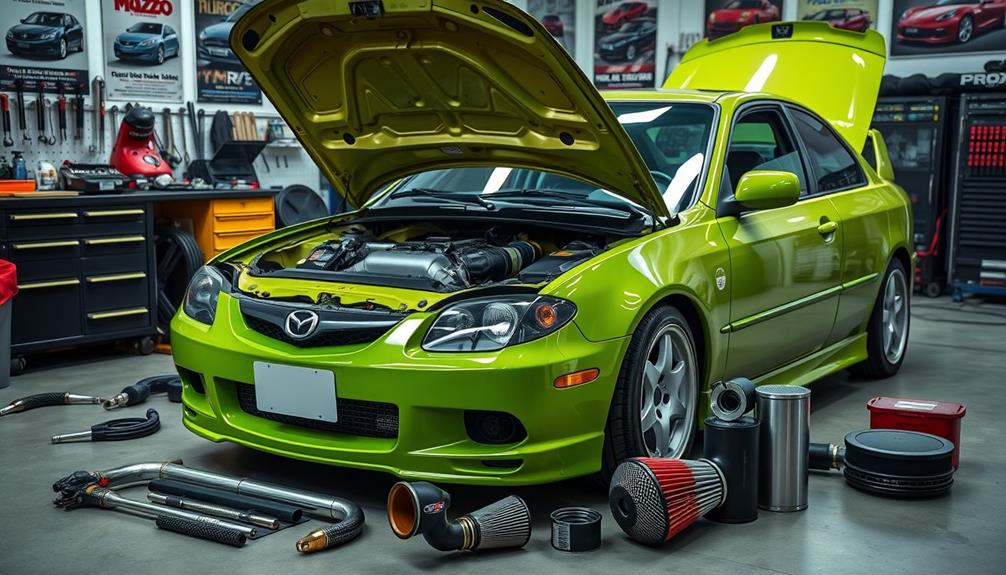
Upgrading your 2000 Mazda Protege can greatly enhance performance without breaking the bank. When considering the cost-effectiveness of upgrades, you'll find that incremental modifications, such as intake and exhaust upgrades, can provide around 20-25 whp gains at a minimal cost. These are some of the most cost-effective choices available.
You should also think about lightweight modifications, like lightweight wheels and flywheels. These can considerably improve acceleration and throttle response without requiring a hefty investment.
In contrast, while turbocharging offers substantial power increases, it typically demands an initial outlay of over $2500—making it less suitable for those on a tight budget.
Evaluating the cost-per-horsepower ratio is essential when deciding on upgrades. Forced induction often provides more power per dollar spent compared to naturally aspirated setups.
Keep in mind that engaging with the automotive community can provide valuable insights. By learning from others' experiences, you can identify practical, cost-effective tweaks that align spending with your performance goals.
Community Experiences and Tips

When tuning your Mazda Protege 2000, it's essential to gather insights from the community on common modifications and their performance impacts.
You'll find plenty of enthusiasts enthusiastic to share their experiences, whether it's about power gains or troubleshooting issues.
Engaging in these discussions can help you make informed decisions and avoid common pitfalls.
Common Modifications Insights
Many enthusiasts kick off their tuning journey for the 2000 Mazda Protege with basic bolt-on modifications like intake systems, headers, and exhausts. These upgrades can yield noticeable power gains of about 20-25 wheel horsepower (whp).
However, it's vital to guarantee proper installation and tuning; misalignment or incorrect settings can lead to performance issues and reduce efficiency.
Lightweight wheels and flywheels are also popular choices among the community. They greatly improve acceleration and throttle response, enhancing your overall driving experience.
If you're looking for more substantial performance improvements, consider an MP3 ECU reflash, which optimizes engine parameters for better power delivery in naturally aspirated setups.
Don't underestimate the value of engaging with the automotive community. Sharing experiences and recommendations can provide you with invaluable insights into effective mod combinations.
This connection can help you avoid pitfalls associated with aggressive modifications, guaranteeing a smoother tuning journey. By starting with the right modifications and leaning on community knowledge, you'll maximize both power and efficiency in your Mazda Protege.
Happy tuning!
Performance Gains Sharing
Sharing performance gains within the Mazda Protege community can really boost your tuning experience. Hearing from fellow enthusiasts can lead to valuable insights that enhance your car's performance.
Here are some tips that community members have shared:
- Intake, Header, and Exhaust Upgrades: Many report a power increase of 20-25 whp while keeping your car drivable.
- Address Vacuum Leaks: These can cause RPM instability, negatively impacting overall engine performance.
- Lightweight Wheels and Flywheel: Upgrading to these can considerably improve acceleration and throttle response, making your ride more enjoyable.
- Throttle Body Spacer: Installing one can optimize airflow, enhancing the efficiency of your other performance modifications.
Engaging with fellow modifiers in online forums is a great way to discover cost-effective upgrades that yield noticeable performance gains.
By sharing experiences and tips, you can refine your tuning process and achieve the best results for your Mazda Protege.
Don't hesitate to ask questions or share your findings; the community thrives on collaboration!
Troubleshooting Tips Exchange
Troubleshooting common issues in your Mazda Protege can be just as rewarding as discovering performance gains.
If you're experiencing low idle or engine RPM oscillation, the problem might lie in the throttle stop screw adjustments or vacuum leaks. Start by inspecting these areas thoroughly.
Using a scan tool to monitor the throttle position sensor (TPS) signal is highly recommended. Adjust the TPS for peak performance, and don't forget to clean the throttle body. This can enhance airflow and potentially resolve stalling issues, especially after you've corrected the throttle stop screw positions.
If you're still facing idle fluctuations, try disconnecting the battery for several minutes. This can reset the engine computer and may help stabilize your idle.
The community emphasizes understanding these adjustment processes, which can save you from overcharging at repair shops.
Engine Modification Strategies
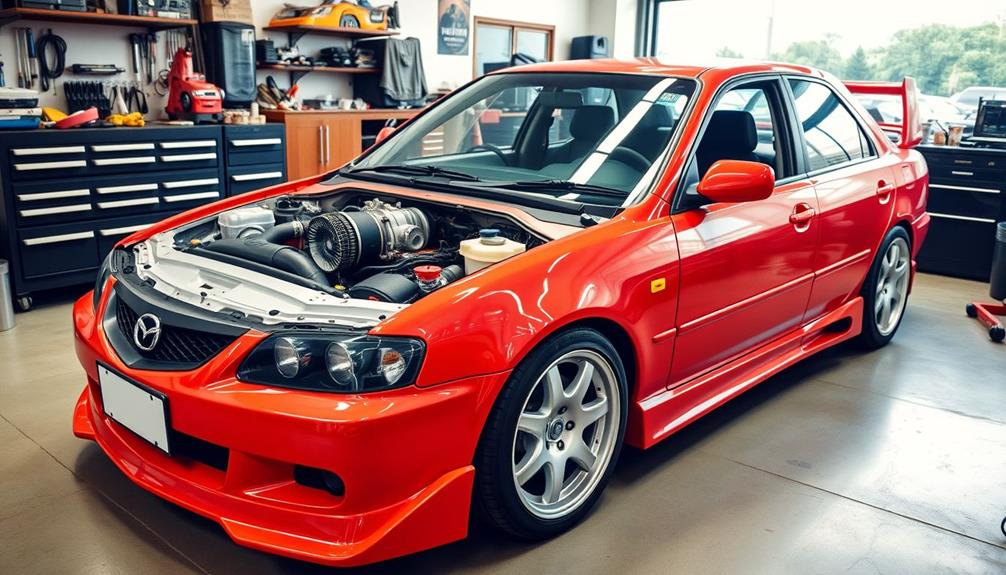
When it comes to tuning your 2000 Mazda Protege, a few key engine modification strategies can greatly enhance performance.
By focusing on optimizing airflow and engine efficiency, you'll set the foundation for a powerful ride. Here are some effective modifications to contemplate:
- Upgrade the Intake and Exhaust Systems: Installing headers and straight piping can yield a power increase of about 20-25 whp.
- Adjust Cam Gears: Fine-tuning valve timing can maximize power delivery and overall engine performance, especially when paired with other upgrades.
- Install Lightweight Components: Switching to lighter wheels and flywheels reduces rotational mass, enhancing acceleration and throttle response.
- Reflash the ECU: A reflash of the MP3 ECU will markedly improve responsiveness and power output for naturally aspirated setups.
For even more performance, contemplate internal modifications like camshaft upgrades and ported cylinder heads.
Targeting a power goal of 180-200 hp at the crank will require these enhancements.
Enhancing Drivetrain Performance
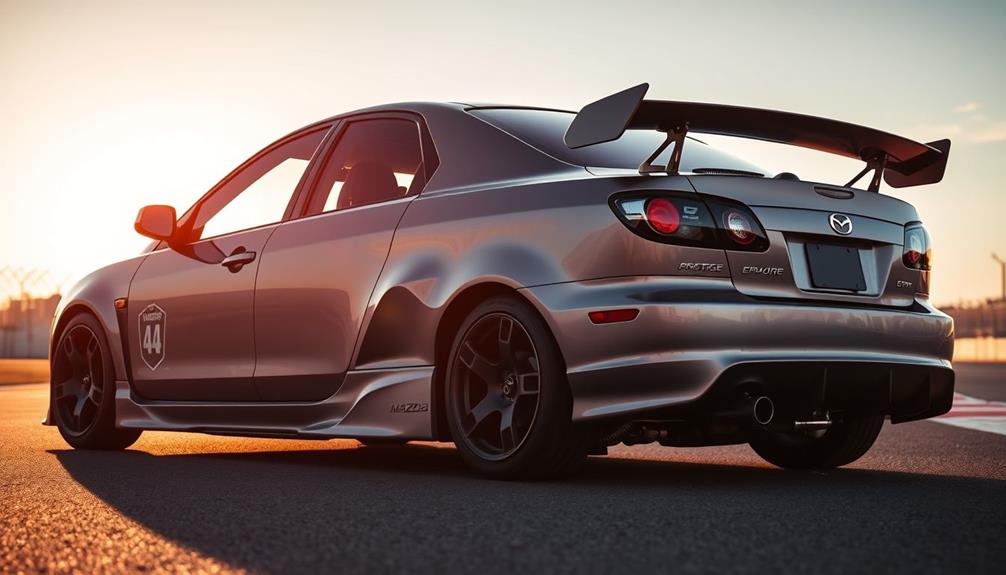
To enhance your Mazda Protege's drivetrain performance, start by focusing on weight reduction strategies like lightweight wheels and a flywheel upgrade.
These modifications not only improve acceleration but also make your ride more responsive and fun.
Pairing a performance clutch with the right flywheel can optimize power transfer, giving you a more efficient driving experience.
Weight Reduction Strategies
The Mazda Protege 2000's performance can be dramatically enhanced through effective weight reduction strategies, particularly in the drivetrain. By shedding excess weight, you'll notice significant improvements in acceleration and throttle response.
Here are some key weight reduction strategies you can implement:
- Lightweight Wheels: Upgrade to lightweight alloy wheels to reduce unsprung mass, improving handling and acceleration.
- Lighter Flywheel: Swap out the stock flywheel for a lighter option, which enhances throttle response and reduces rotational mass.
- Remove Unnecessary Components: Take out rear seats or sound deadening material. You'll maintain essential comfort while decreasing overall weight.
- Racing Components: Invest in lightweight racing parts like aluminum control arms or a carbon fiber driveshaft to enhance handling and responsiveness.
Implementing these weight reduction strategies can yield performance gains equivalent to, or even greater than, traditional power-adding modifications.
Not only will you enjoy better acceleration, but you might also see improvements in fuel efficiency. By focusing on reducing weight, you're setting yourself up for an exhilarating driving experience with your Mazda Protege 2000.
Clutch and Flywheel Upgrades
Upgrading the clutch and flywheel in your Mazda Protege 2000 can considerably enhance drivetrain performance, transforming your driving experience. A lightweight flywheel can reduce rotational mass by 5-10 lbs, resulting in quicker throttle response and improved acceleration. This means you'll feel a noticeable difference when you press the gas pedal.
Pairing this with a performance clutch is vital. A performance clutch typically offers a torque capacity between 300-400 ft-lbs, allowing your vehicle to handle increased power from engine modifications without slipping. Opting for a clutch with a higher friction material will provide better grip, minimizing slippage during aggressive driving, and optimizing power transfer from the engine to the wheels.
However, it's essential to verify compatibility between your chosen clutch and flywheel weights. Mismatched weights can lead to vibrations and premature component failure, which can be frustrating and costly.
With the right pairing, you can expect a significant improvement in your acceleration times, often enhancing 0-60 mph performance by 0.2 to 0.5 seconds, depending on your overall setup. Upgrading your clutch and flywheel not only elevates performance but also elevates your entire driving experience.
Addressing Idle and RPM Issues
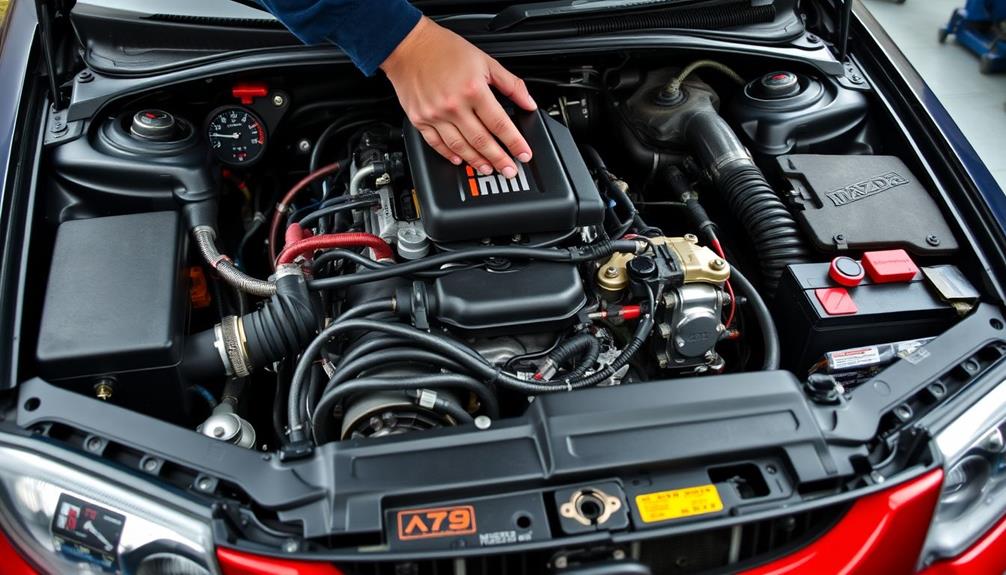
Idle and RPM issues in the 2000 Mazda Protege can be frustrating for drivers, often stemming from a variety of mechanical factors. These problems can manifest as low idle issues, RPM fluctuations, or even persistent cycling around 1850 RPM.
To tackle these issues effectively, consider the following steps:
- Throttle Stop Screw Adjustment: Confirm your throttle stop screw is properly adjusted to stabilize idle levels and minimize fluctuations between 1900 and 2500 RPM during acceleration.
- Throttle Position Sensor (TPS): If you've replaced the TPS but still face idle issues, don't rule out other potential culprits, such as vacuum leaks.
- Throttle Body Cleaning: Clean the throttle body after making adjustments. This helps confirm ideal airflow, contributing to improved idle stability.
- Reset the Engine Computer: Disconnecting the battery for a few minutes can reset the engine computer, which may resolve idle issues related to electronic adjustments.
Diagnosis and Repair Solutions

Addressing idle and RPM issues is just the first step in getting your 2000 Mazda Protege running smoothly. To diagnose low idle problems, start by adjusting the throttle stop screw and checking for vacuum leaks, which often cause RPM instability.
Using a scan tool to monitor the throttle position sensor (TPS) signal can pinpoint issues related to idle fluctuations effectively.
If you notice the check engine light on with trouble code PO-106, it's time to investigate the TPS and its related components further. Cleaning the throttle body is also essential after making any adjustments, as this improves airflow and guarantees your engine operates smoothly at idle speeds.
While you can tackle some of these steps yourself, professional assistance is advisable for repairs. Local shops equipped with advanced scanners can efficiently address idle issues, typically within an estimated labor time of one hour.
This not only saves you time but also ensures that any underlying problems are properly resolved, allowing you to enjoy peak performance from your 2000 Mazda Protege. Don't hesitate to seek expert help if you're unsure about any aspect of the diagnosis or repair process.
Expert Resources and Support
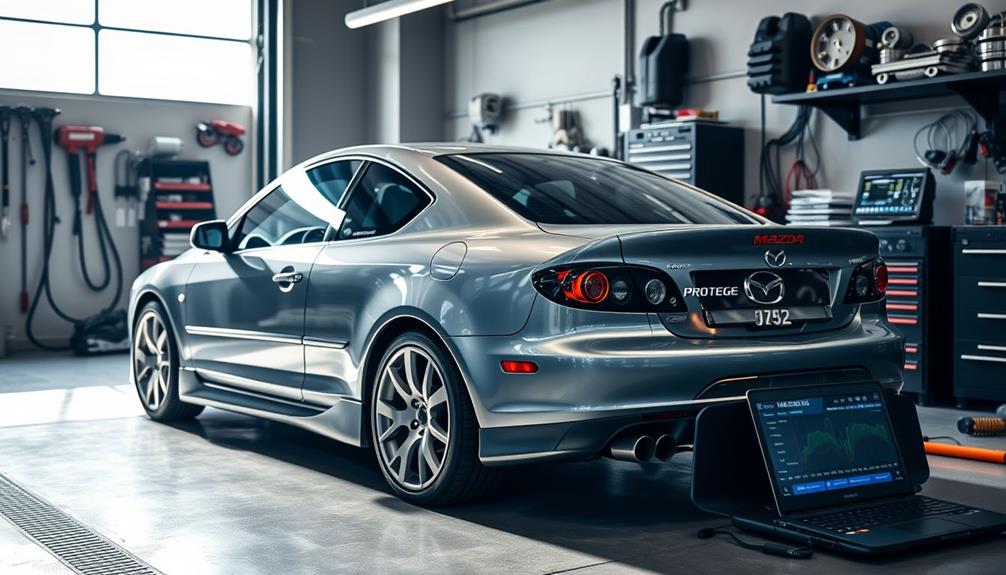
Finding expert resources and support can make all the difference when tuning your 2000 Mazda Protege. With the right guidance, you'll enhance your car's performance effectively. Here are some valuable resources to reflect upon:
- Automotive Experts: Gain access to over 12,000 verified automotive experts available 24/7 for tuning and performance inquiries. Their timely assistance can guide you through challenges.
- Community Forums: Engage with fellow Mazda enthusiasts through forums. You'll find practical insights and shared experiences about specific modifications that can enhance your Protege.
- Diagnostic Tools: Utilize scan tools to monitor performance metrics and troubleshoot issues. These expert resources will help you understand your car's needs during the tuning process.
- DIY Kits and Gear: Invest in port and polish sanding kits alongside protective gear. These essential resources empower you to tackle engine modifications hands-on, optimizing performance.
Frequently Asked Questions
How Many Miles Can a Mazda Protege Last?
A well-maintained Mazda Protege can last between 200,000 to 300,000 miles. By staying on top of regular maintenance, like oil changes and timely repairs, you can help your vehicle reach its maximum lifespan.
How Much Horsepower Does a Mazda Protege Engine Have?
The Mazda Protege's engine typically has around 120 horsepower at the crank. With modifications, you could boost this output to 140-150 horsepower, enhancing your car's performance and making your driving experience more enjoyable.
How Much Horsepower Does a 99 Mazda Protege Have?
The 1999 Mazda Protege offers a modest 105 horsepower from its 1.6-liter engine, or 130 with the 2.0-liter variant. You'll notice drivetrain losses can reduce that to about 80-90 horsepower at the wheels.
How Fast Is a Mazda Protege?
A Mazda Protege typically reaches a top speed of about 121 mph. With some tuning and modifications, you could potentially boost that speed closer to 140 mph, enhancing your driving experience considerably.
Conclusion
In the world of tuning your 2000 Mazda Protegé, think of your car as a blank canvas waiting for your artistic touch. With the right modifications, you can release a symphony of power and efficiency that'll make your heart race. Embrace the journey of upgrades, learn from fellow enthusiasts, and don't shy away from tackling challenges like idle issues. Immerse yourself, and watch your compact car transform into a thrilling ride that mirrors your personal style and passion. With endless possibilities at your disposal, consider starting with the essential Mazda Protege 2001 performance upgrades, such as a cold air intake, exhaust system improvements, or ECU tuning to optimize your engine output. Each adjustment brings you one step closer to creating a truly unique driving experience, allowing your vehicle to not only keep up with modern cars but also exceed expectations on the road.

